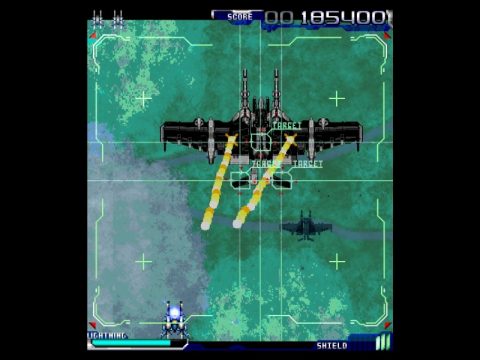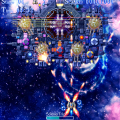In the closing years of the 20th century a small, officially three-person, doujin studio called SITER SKAIN was working on a game to be released on a fresh, new platform – Windows PC. The studio managed to release this first game, KAMUI, in 1999, and started work on another one, before getting bogged down in development hell for the next nine whole years. As a testimony to the developer’s prowess, however, for once it was well worth the wait: RefleX, the prequel to KAMUI that took most of those nine years, is likely the best PC original shoot-’em-up, and ALLTYNEX Second, SITER SKAIN’s third game is pretty good as well. Collectively the three are known as The Tale of Alltynex, and are one of the few doujin games to recieve a proper western release.
What sets the games apart from other examples of the genre and makes them an unique take on the bullet hell approach is the defensive prowess of the player’s craft – in each game the player’s ship can take at least one hit before exploding, and has further defensive mechanisms that, with careful use, allow to cancel almost any attack thrown at it. Stages are carefully built around each game’s central mechanic in such a way to encourage score attacks by finesse, rather than blunt firepower, but also try to mix things up a bit – for example, RefleX’s final two stages, while still technically revolving around the same core idea, play completely different (and are infamously hard).
The three games were released in a reverse chronological order – KAMUI, the first game released, is actually the series ending, taking place many centuries after RefleX, and is largely self-contained as a story, though still tying up a few leftover plot threads presented in the prequel. RefleX is probably the most plot involved game, where plot twists actually happen, powers shift, and important characters from both KAMUI and ALLTYNEX Second make an (albeit very brief and more or less background) appearance. Finally, ALLTYNEX Second, the last game released, actually sets the scene by providing background for the other games. What makes this notable is that for such an odd release order, both in reference to internal chronology, and regarding the fact that it took over eleven years to complete the series, SITER SKAIN managed to fit in an incredible amount of callbacks and references that actually become meaningful and important once the player is familiar with the entire trilogy – for example, the distinct set of light wings that appears at pivotal points in each game, or the recurring boss, Scorpio, whose presence in each game could actually be reasonably explained in-story. There’s even an 80+page official guidebook containing, among other things, relevant background information, showcasing the developer’s incredible attention to detail.
Centuries ago a terrible disaster befell humanity. Losing much of their technical knowledge and prowess, humans were forced to rebuild their civilization literally from scratch, even though some of their old creations remained, out of their reach, silently watching from the heavens. When an ancient supercomputer known as Neural Nest had awakened, bent on wiping humans once and for all, a small craft launched high in the Earth’s orbit. This so-called “Twin-tined Instrument of Mankind’s Destruction”, KAMUI unit #2, would ironically be the mankind’s last hope…
SITER SKAIN’s first game seems at first glance to be just a RayForce clone, and while this assessment indeed rings true, KAMUI is more than that. Much like in RayForce, the game’s play area is divided into foreground and background, and the player craft, the eponymous KAMUI, is equipped with weaponry to deal with both. The most basic weapon is an upgradeable pulse laser, initially rather weak and forward firing, and eventually not much stronger, but covering a large area and doing a decent job of clearing the foreground of weak enemies. The next weapon is the Lock-On Thunder, which is a lightning discharge that automatically targets every enemy, as well as missile, located in the background. The actual number of enemies hit depends on how charged the craft’s power meter is, and varies from one to sixteen – if there are fewer enemies than there are lightning bolts fired, some will be hit multiple times for greater damage. The last weapon equipped, used by pressing both attack buttons at once, is the Thunder Sword, which is a powerful, forward firing beam attack that deals enormous damage, and cancels any bullet or laser it comes in contact with, even sending some right back at the enemy. The catch is, it runs on the same power meter as the Lock-On Thunder, filling it from the other side and temporarily preventing recharge.
The weapons’ description might seem simple enough, but there’s a fascinating amount of depth to it – for example, the Lock-On Thunder might be charged faster by holding down its button, but this prevents the player from firing – releasing the button means launching the attack, and pressing the other button means launching the attack and firing the Thunder Sword. Since enemies might attack from both the foreground and the background, and the bullet pattern is often too tight to simply maneuver around – the opposition also frequently employ the RayStorm-esque homing lasers – careful juggling of Lock-On and Sword with pauses to recharge their power meter will be required in order to safely pass each stage. This is further complicated by the scoring system – destroying enemies with the pulse laser or the Thunder Sword gives just the base amount of points, while enemies destroyed by the Lock-On Thunder have their score value multiplied by the amount of individual bolts launched, so if it was used at full charge, every enemy destroyed with it will bear a x16 multiplier. Predictably, every boss enemy has a phase when it’ll retreat into the background, allowing for a small window of vulnerability to the highest-scoring weapon.
KAMUI is not a long game by any means – just five stages and the final boss clocking at about 20-25 minutes total. Every stage has a different theme, there’s one in space, another is set over a floating continent, and yet another makes the player descend deep into a mineshaft and then fight up a garbage disposal tunnel. The developers tried to pack different challenges into each stage in an effort to keep things fresh, for example while most of the time the enemies will approach from background or from top of the screen, during the mineshaft dive new opponents will often dive in from the foreground. Interestingly enough, despite their variety, every stage is actually connected to the previous one with a believable transition: the first stage, set in Earth’s orbit, ends with a descent into atmosphere, where the first boss is fought, the second stage ends over a forest, the third stage begins over said forest before quickly entering a large cave hidden among trees, and so on. This connection and logical flow would be present in later games as well. In the end though, for all their variety, the stages in KAMUI are still a relatively mundane deal – always flying forward over vaguely sci-fi landscapes with an occasional hovering against a boss enemy. Apart from the stages themselves, there’s not much to do in the game, too – there are three difficulty levels, there’s an alternate ship to unlock, but it’s significantly weaker than the starting one, there’s a stage replay mode, and that’s it.
The game’s biggest weakness are probably its audiovisuals. The graphics side did not age very well and while it’s not repulsive by any means, it pales in comparison with other sprite based shoot-’em-ups – the colors are washed out, most enemies are a variation on “blocky shape on wings”, or “blocky shapes mashed together” (especially the player’s ship, whatever it’s supposed to be), and very few ships are actually animated, fewer still with more than a handful of frames. Furthermore, the scaling engine used to move ships between foreground and background or rotate them often generates tiny but still noticeable artifacts. The sound effects are as bland as they come and lacking in variety, each enemy sounding the same. The game redeems itself though with its amazing soundtrack: even though the instrument choice is more or less midi crossed with techno, every stage theme is at the very least good, with some, like the iconic Stage 1 – Final Hour, or Stage 4 – Worthless Creatures being plain amazing pieces of game soundtrack work that greatly contribute to the game’s somber, melancholic mood.
When you put all the pieces together, what comes out is an amazingly focused, elegant experience – the pacing is just fast enough, the weapons feel right, and the stages offer challenge without feeling overwhelming, encouraging 1CC and score runs. It’s also the most straightforward entry in the Alltynex trilogy, being more or less “RayForce on steroids” – the other two games are far more nonstandard takes on the genre.


